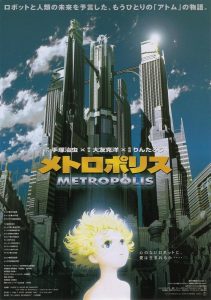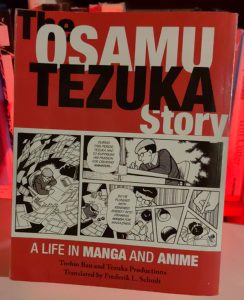Rintarô’s Life in “24 Frames per Second”


This month a new autobiographical manga was released on the life of a prominent animator; My Life in 24 Frames Per Second by Shigeyuki Hayashi aka Rintarô. Known for his work directing films like Galaxy Express 999 (1979) and series like Captain Harlock (1978), Rintarô’s first gig dates back to Japan’s first color animated film, The White Snake Enchantress (1958 – aka Panda and the Magic Serpent).
 This manga follows Rintarô’s life journey from growing up through childhood in the aftermath of WWII where he discovered and fell in love with the cinema and animation, to eventually pursuing and finding a career in the fledgling anime industry. Along the way we witness anime’s domestic growth and its slow methodical evolution over the decades paralleling Rintarô’s struggles to fulfil his own calling to write and direct a film all of which culminates in the production of Metropolis in 2001.
This manga follows Rintarô’s life journey from growing up through childhood in the aftermath of WWII where he discovered and fell in love with the cinema and animation, to eventually pursuing and finding a career in the fledgling anime industry. Along the way we witness anime’s domestic growth and its slow methodical evolution over the decades paralleling Rintarô’s struggles to fulfil his own calling to write and direct a film all of which culminates in the production of Metropolis in 2001.
This is a powerfully personal story written like a screenplay, each of the seven chapters are designated as sequences of a film. Rintarô’s father, a significant presence in Rintarô’s life and the book, is the origin of Rintarô’s introduction to theatrical arts. Unlike Rintarô, his father’s pursuit of artistic expression would not yield success and instead drive a wedge into his family, pushing Rintarô away for most of his adult life. This complicated relationship is made even more challenging when Rintarô’s career pulls him towards and grows closer to Osamu Tezuka, whose passions about film reflect and mirror Rintarô’s. The book is as much a record of the life of Rintarô as it is a love letter to the father figures who have inspired Rintarô’s life pursuits.
This book covers a lot of ground in a relatively short amount of time. Highlights include Rintarô’s first roles at Toei Animation working on films like the aforementioned The White Snake Enchantress (1958) and Alakazam the Great (1960). It details the significance and long term impacts of meeting and working with Osamu Tezuka on Astro Boy (1951) and the successes and challenges it brought to Mushi Productions, and eventually, Tezuka Productions. Kimba the White Lion (1965) and other Tezuka productions and sub-contractual obligations are shown, including the work done on The Moomins (1990). As Rintarô moves from one production to the next, he gives context for and acknowledges other artists that were responsible for bringing these projects into fruition. It is here that the medium of manga shines, showing the fragmentation and work-from-home culture predominate in the Japanese animation industry that we still see today.
 Stylistically, My Life in 24 Frames Per Second plays with a couple of styles throughout the 250 page hardcover – real posters, screenshots of anime, or photography is often used side by side with Rintarô’s drawings. Rintarô’s linework also playfully bounces between styles to emphasize a serious moment or comedic beat – occasionally panels are drawn like doodles or hyper-realistic portrayals. Full page splashes are saved for significant moments in Rintarô’s life, like first time visits or mental exhaustion. Panels sometimes even repeat for an interesting motif and I cannot neglect Rintarô’s cat making quite a few cameos throughout.
Stylistically, My Life in 24 Frames Per Second plays with a couple of styles throughout the 250 page hardcover – real posters, screenshots of anime, or photography is often used side by side with Rintarô’s drawings. Rintarô’s linework also playfully bounces between styles to emphasize a serious moment or comedic beat – occasionally panels are drawn like doodles or hyper-realistic portrayals. Full page splashes are saved for significant moments in Rintarô’s life, like first time visits or mental exhaustion. Panels sometimes even repeat for an interesting motif and I cannot neglect Rintarô’s cat making quite a few cameos throughout.
My Life in 24 Frames Per Second is a fire starter! If that fire in your belly has started to dim, Rintarô’s dogged and relentless pursuit of finding his own place in life and finding true expression through the arts is a powerful reminder that life puts many challenges between the places we’d like to be, where we end up finding ourselves, and the timing required of all of the variables involved. Throughout Rintarô’s life there are minor and huge setbacks, gatekeepers preventing forward progress, uninspiring projects that drain creative energy, and the challenge of people who come into and leave his life.
My Life in 24 Frames Per Second is a personal and powerful story of the life of Rintarô and the growth of the anime industry. It was published by KANA Manga and Harry N. Abrams. This manga is printed left to right as the original release was a French release from this past January, Ma vie en 24 images par seconde, published by KANA Manga.
 Not only does Rintarô’s autobiography stand on its own, but it also serves as a fantastic companion piece to Osamu Tezuka’s manga biography, The Osamu Tezuka Story: A Life in Manga and Anime released in 2016 and translated by Frederik L. Schodt. And if that’s still not enough anime history in manga form then check out the lighthearted, but factually based, The Men Who Created Gundam by Hideki Ohwada, Hajime Yatate and Yoshiyuki Tomino.
Not only does Rintarô’s autobiography stand on its own, but it also serves as a fantastic companion piece to Osamu Tezuka’s manga biography, The Osamu Tezuka Story: A Life in Manga and Anime released in 2016 and translated by Frederik L. Schodt. And if that’s still not enough anime history in manga form then check out the lighthearted, but factually based, The Men Who Created Gundam by Hideki Ohwada, Hajime Yatate and Yoshiyuki Tomino.
As a parting shot – below is the trailer for Metropolis (2001), directed by Rintaro, based on the classic Osaka Tezuka manga – and adopted for the screen by Katsuhiro Otomo (Akira).
As for me, I’m continuing work on the second edition of the Bibliography and I am excited to share an update with you all soon! Please dive in and enjoy the complete Animation History Bibliography section of the Cartoon Research website. See you next month with another round up of animation book news and reviews!
